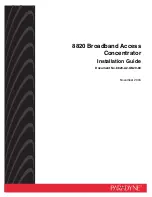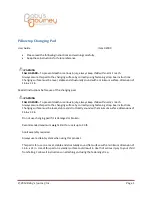
P51923
Rev 01
Effective: April 2007
Page 2
Questions? Call our Sensor Application Engineers at (800) 426-9184.
4,000 ohms should provide a load of 30 mA at 120V AC, or a night light
bulb of 4 watts should relate to 33 mA. With the load energized and
passing through the sensing aperture, turn the potentiometerclockwise
until the sensor trips. Then, back one-eighth of a turn and the setpoint
should be correct.
When used with an external current transformer (CT), the sensor will
be set to trip at a point much lower than without the CT. This set point
adjustment should be done with the load passing through the CT in that
application.
POWER SUPPLY NOTES
All low-current ground-fault sensors are sensitive devices that require
reasonable care in system design to avoid false trips caused by high
electrical noise levels. Keep in mind that the best way to reduce noise in
a system is to suppress it at its source.
• Keep the sensor power isolated from noisy circuits
• Do not power the sensor with the same circuit that switches
contactors or other high current inductive loads
SYSTEM GROUNDING
Good design practice and code require that all AC power systems be
grounded. The EGF Series sensors are designed to work on grounded
AC power systems. They may not operate properly on ungrounded
systems.
SPECIFICATIONS
Specifi cation
Value
Power Supply
120V AC (Operates from 66-132V)
24V AC/DC (Operates from 19.2-28.8V)
Voltage Range
Up to 1,500V AC (Monitored Circuit)
Power Consumption
2.5W
Output
Latching Electromechanical Relay
Normally Open Models Latch Closed Upon Sensed Fault Current
Normally Closed Models Latch Open Upon Sensed Fault Current
Output Rating
1.0A @ 120V AC
2.0A @ 30V AC
Response Time
At 5% Over Setpoint: 200 ms
At 50% Over Setpoint: 60 ms
At 500% Over Setpoint: 15 ms
Setpoint Range
Selectable by Model
Fixed Setpoints: 50, 100 mA
Adjustable Setpoints: 5, 10, 30 mA (By Jumper)
Setpoint Adjustment
See “Adjust Setpoint” in “Operation” Section
Frequency Range
50-400Hz (Monitored Circuit)
Housing
UL94 V0 Flammability Rated
Dimensions
Case: 2.5 in. H x 2.8 in. W x 1.5 in. D (64x71x38mm)
Aperture: 0.75 in. (19mm)
LED
Green = Power Supply Energized
Red = Relay Has Operated
Environmental
Operating Temperature: +5 to +158° F (-15 to +70° C)
Humidity: 0-95% RH, Non-Condensing
Approvals
UL Recognized
490050021
WIRING
Use up to 14 AWG copper wire and tighten terminals to 4.5 inch-
pounds torque. See diagram below.
Power
Connect power wiring to Terminals 1 and 2. Be sure that the power
supply matches the power rating on the sensor label.
Output
Connect output wiring to Terminals 3 and 4.
Reset Switch
Connect a momentary dry contact to the Reset Terminals 5 and 6. Limit
wire run to 200 feet of 18 AWG or larger wire.
Momentary Reset
Only close the reset terminals momentarily—the sensor will not work
properly if the reset terminals are closed (shorted) continuously. Limit
wire run to 200 feet of 18 AWG or larger wire.
Parallel Reset Connection
Multiple sensors may be connected to the same reset switch in parallel.
Only the sensors that have detected a fault and have latched will
be reset. A sensor will not reset unless the fault has dropped below
setpoint.
OPERATION
The EGF Series latching ground fault sensors operating in one of two
states: Reset or Latched. If control power is removed, the sensor
remains in it’s last state (latched or reset).
Reset
The sensor has not detected a fault and the output is in the “normal”
position. For Normally Open (N.O.) sensors, the contact is normally
open in the reset condition. For Normally Closed (N.C.) sensors, the
contact is normally closed in the reset position.
Latched
Upon detecting a fault or when the TEST switch is pressed, the output
will switch and “latch.” The output will remain latched until the ground
fault is removed and the output is reset by a momentary dry contact on
Terminals 5 and 6.
Testing
To test operation, gently press the TEST button. This simulates a fault
and tests the internal switching circuits. After the test is complete,
reset the sensor with a momentary dry contact on Terminals 5 and 6.
CAUTION: Any circuit connected to the sensor will be operated.
Adjusting Setpoint
While not as precise as having it set at the factory, the setpoint can be
adjusted in the fi eld. See wiring diagram for location of potentiometer.
The best way to adjust the trip point is to develop a load of the
magnitude at which you want the sensor to trip. A resistor of
Red Status LED (On When Tripped)
Setpoint Adjustment
(Located Under Label)
Test Button
(Caution: Will Activate Output Relay)
External Reset Button (5 and 6)
Output (3 and 4)
Power Supply Input (1 and 2)
Power (Green) LED
(On if Power is Applied)
1
2
3
4
5
6
G
R
TEST




















